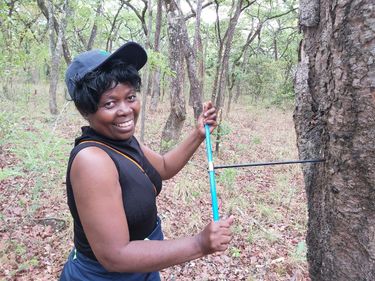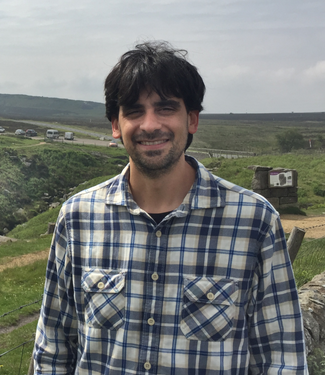
Sessions in which Joe Buck participates
Thursday 30 June, 2022
Allies have emerged as key enablers of diversity and inclusivity initiatives in the workplace, in professional associations, and in everyday life. But what is an ally? What skills are required to be an effective ally? How do we hold ourselves and our community members accountable for being effective allies? This symposium will provide a deeper understanding of what it means to be an ally and the skills to help advance allyship as individuals and as a community. Fur...
Sessions in which Joe Buck attends
Monday 27 June, 2022
Blue Intensity (BI) is a cost-effective analytical method for measuring relative wood density in the rings of conifer tree species. Since early concept papers in the 1990s/2000s, there has been a recent explosion in the application of this method for both dendroclimatology and historical dating as well as other dendro-disciplines. The beauty of BI is that the analytical costs, mainly related to the cost of a h...
Free, in person and onlineWe will hold a practical, skills-based workshop introducing openDendro -- an open-source framework of the base analytic software tools used in dendrochronology in both the R and Python programming languages. openDendro is a new unified set of tree-ring analysis tools in open-source environments that provides the necessary baseline for dendro...
Meet colleagues and friends in an informal settingFree drinks for all!
Tuesday 28 June, 2022
Africa is faced with a number of challenges including climate change and ecological disturbance due to various anthropogenic activities. These problems adversely affect the forests and also ecosystem services. My appreciation for the forests motivated me to pursure my undergraduate studies in Forestry. I first applied dendrochronology during my PhD research which focused on understanding the climate change vulnerability of the Zambezi teak forests in Zambia. However, lack of research facil...
Tree-ring time series provide long-term, annually resolved information on the growth of individual trees. However, public tree-ring archives contain a considerable portion of data collected from trees that have been selected with specific research questions in mind (e.g., for climate reconstruction). This makes these archives a biased representation of the sensitivity of forest ecosystems to ongoing climate variation (e.g. temperature, precipitation), including non-stationarity (i.e....
Tree rings have long been used to monitor forest change by measuring differences in tree ring widths through time derived from a representative sample of forest trees. However, for many reasons, tree rings have only rarely been utilized to monitor urban forest change. Urban forest change monitoring has more commonly occurred with time-series of remote sensing imagery, such as yearly stacks of Landsat satellite imagery converted to some vegetation index or other proxy. Tree rings and remote...
Urban trees are expected to help in mitigating the negative effects of climate change on infrastructures and human well-being in cities but warming climate with longer and more intensive dry and hot periods will also affect urban tree function and survival. To better understand the resilience and resistance of urban trees in the face of climate change, we conducted a Canada-wide collection of tree cores from cities with diverging climates (Edmonton, Montreal, Quebec City, and Halifax).&nbs...
Urban trees provide important environmental services and are indispensable for the regulation of a city's climate, whilst growing in stressful conditions with low water and space availability. However, compared to their forest counterparts, little is known about urban trees' capability to cope with climate change. Due to the heat island effect, Montreal has already experienced 1.4°C higher temperatures, creating increasingly challenging conditions for urban trees. Planting resilient trees ...
Urban trees and forests provide a variety of social and environmental benefits, but their function, and therefore the benefits they provide, can be enhanced or diminished by human influences. More work is needed to understand how urban forests mitigate, and are affected by urban heat, pollution, and other anthropogenic influences, especially in light of modern urbanization and climate change. As concentrated sites of accelerated environmental change, urban forests may also provide insight ...
Annually resolved subfossil kauri (Agathis australis) trees, recovered from bogs in northern New Zealand, provide unique insights into past climate events over multi-millennial timescales. Their tree-rings faithfully capture annually resolved information about climate and carbon dynamics occurring during their lifespan. Preserved material has contributed tree-ring chronologies spanning much of the Holocene and extending into the late Pleistocene (i.e. the last 50,000 years). A recently dis...
Fire regimes shaped forest ecosystems for centuries in the southwestern United States prior to a century of fire exclusion. Tree-ring fire history studies have been vital to our ecological understanding of fire regimes and to inform management. Regional-scale synthesis efforts have revealed the strong connection between fire and climate, but by focusing on coarse-scale patterns over time, such studies may have overlooked finer-scale interactions of fire, climate, vegetation, and human acti...
Indigenous land stewardship and mixed-severity fire regimes both encourage landscape heterogeneity and the relationship between them is an emerging area of research. To contribute to this exploration, we reconstructed the historical fire regime of Ne Sextsine, a 6000-ha dry, Douglas-fir-dominated forest in the traditional territory of the T’exelc (Williams Lake First Nation) in British Columbia. Between 1550 and 1982 CE, we found median fire intervals of 15 years at the plot-level and 4 ye...
There is a growing need for improved methods and approaches for managing wildfires in British Columbia, as uncharacteristically large wildfires exceed government capacities for control and suppression. The 2018 Tweedsmuir complex fire exceeded half a million hectares, negatively impacting several endangered species and the ecosystems they depend on. Tweedsmuir Provincial Park is one of BC’s largest protected areas and plays a critical role in connecting diverse landscapes and allowing plan...
The most frequent fire regimes in the world exist in environments that balance maximum fuel production and maximum fire occurrence potential. Often these environments exist at low elevations, correspond to subtropical climates, and have long growing seasons that push the limits of reliable annual ring formation. Historical fire regimes in ecosystems with these conditions are poorly studied. We investigated fire scarring in such conditions in southwestern Georgia, USA and successfully const...
Drought, flooding, and hurricane activity disrupt the human and natural landscape throughout the southeastern United States. Instrumental records through the past century suggest that the patterns of these extreme events are changing through time, especially in relation to rising global temperatures. However, instrumental records before the industrial revolution are rare, thus proxy records like tree rings are useful for comparing climatological conditions before massive human modification...
Wednesday 29 June, 2022
Dendrochronology is considered one the most precise of all the scientific dating techniques. However, it requires long sequences of tree rings and a master record for both the species and region in question. At the University of Groningen, we have been pioneering a new approach to dating that combines the precision of dendrochronology with the versatility of radiocarbon dating. It relies on the detection of spikes in the annual radiocarbon record, thought to b...
Information garnered from historical timbers and wooden artifacts (e.g. houses, barns, ships) can greatly enhance our understanding of human, ecological, and climate history, especially in regions where few old-growth forests and trees remain, tree longevity is relatively short (less than 300-400 years), and environmental conditions break down wood rather quickly, like in mesic to wet regions. Over the last decade plus, the application of tree-ring techniques on wo...
Information garnered from historical timbers and wooden artifacts (e.g. houses, barns, ships) can greatly enhance our understanding of human, ecological, and climate history, especially in regions where few old-growth forests and trees remain, tree longevity is relatively short (less than 300-400 years), and environmental conditions break down wood rather quickly, like in mesic to wet regions Over the last decade plus, the application of tree-ring techniques on woo...
In eastern boreal Canada, in the absence of long gauge records, changes in tree-ring anatomy of periodically flooded trees have allowed reconstruction of spring floods in natural rivers. This study analyzes the effect of regulation on the flood rings (FR) occurrence and on ring widths in Fraxinus nigra trees growing at 5 sites distributed along the Driftwood River floodplain to determine if a flood reconstruction using FR could be done in regulated rivers. Driftwood River was regulated by ...
Trait plasticity supports tree growth and survival in multiple environments and is important at the edges of species ranges, with limited tree growth. Xylem anatomical traits determine sap, nutrient flow and mechanical strength. Trait analysis can provide information on species adaptation to extreme climatic conditions. My project studies xylem anatomical traits over the distribution range of the sugar maple in Quebec, where it finds its northern limit. We intend to understand the links be...
Spatially-resolved climate field reconstructions are ideal for analyzing spatial anomaly patterns and characterizing regional-scale trends resultant from climate change. To date, few fine-scale, spatially-resolved paleotemperature datasets exist in the Northern Hemisphere. Here, we present a 2.5x2.5o temperature field reconstruction of warm season (April-August) mean surface air temperatures, developed from a network of 130 tree-ring chronologies. In the reconstruction’s current form, stat...
As climate change continues at a rapid pace, compounding ecosystem disturbances are becoming an issue of global concern. The limits within which ecosystems operate are likely to be altered by catalytic, or compounding, disturbances, threatening their resilience. Positioned in the heart of the western US, the Greater Yellowstone ecosystem (GYE) is a well-studied and large wildland region dominated by conifer forests characterized by an infrequent, high-severity fire regime with return inter...
Presentation of all Ameridendro2022 posters.FREE LUNCH FOR ALL ATTENDEES!
The Miombo woodlands of interior Africa are fire adapted ecosystems with a relatively open canopy dominated by Brachystegia spp., Julbernardia spp., and Isoberlina spp. These ecosystems are threatened due to deforestation, habitat fragmentation, and impacts from climate change, and in Zambia, they are further threatened by the rapidly growing mining industry which contributes to air pollution, contamination of soils and water, and land degradation. In this study, we used modified variable ...
Dendroclimatology in the tropical forest regions has lagged behind the more temperate forested regions of the world because of the challenge of determining annual ring formation. Despite over 230 tropical tree species known to form annual rings, the ITRDB shows few published chronologies in tropical forests in Sub-Saharan Africa. As part of the first “Training in Tree-Ring Science and its Applications” workshop conducted in Kitwe, Zambia, our team explored the dendroclimatic potential of B...
Session reescheduled from June 28th to June 29th
This is a mandatory (!) .... and FREE (!!) cocktail & award ceremony (!!!)(in replacement of the Banquet formula)->->->->->->->->->->->->->->->->->->After a great summer day of scientific and urban discoveries in our beloved MTL, we wish to bring together all the AmeriDendro community in one place and congratulate the TRS awardees for their remarkable achievements! -Bonsinsegna award-Fr...
Thursday 30 June, 2022
How old are tropical trees? This fundamental question has long driven the curiosity of laymen and scientists. But only recently, a great number of studies conducted by many brave dendrochronologists resulted in a significant tree-ring-based knowledge that allows us to start accurately estimating tree ages across the globe. As science goes, not only knowing the longevity of tropical trees is essential to understanding forest dynamics and its role in biogeochemical cycles, but one must also ...
Dendrochronological archives in the tropics of the Americas have been under-studied for a long time. Some of the challenges include the Identification of tree-ring boundaries in certain tree species, absence of winter dormancy associated to low temperatures in most of the cases, and logistic difficulties of fieldwork in remote sites. However, part of the slow progress is also related to the fact that historically much less resources have been inv...
The occurrence of annual growth rings in tropical trees—the result of the seasonal activity of vascular cambium—has been explained either by seasonal periods of water deficit or flooding. However, little is known about the drivers of annual tree-ring formation under tropical hyper-humid conditions without evident seasonal dry periods or flooding (ever-wet conditions). Shelford's law states that both the deficit and the excess of environmental resources limit plant growth. Accordingly, we h...
Dendrochronological archives in the tropics of the Americas have been under-studied for a long time. Some of the challenges include the Identification of tree-ring boundaries in certain tree species, absence of winter dormancy associated to low temperatures in most of the cases, and logistic difficulties of fieldwork in remote sites. However, part of the slow progress is also related to the fact that historically much less resources have been inv...
A gap of millennial tree-ring data suitable for dendroclimatology has long been evident in the North American boreal forest. In my talk, I will describe the adaptive approach we have developed to build and improve a data network for millennial dendroclimatology in the eastern Canadian taiga. Recurrence of stand replacing wildfires is the most important constrain to the elaboration of long tree ring chronologies, which can only be developed away from regions ...
The interpretation of stable isotopes in a dendroecological framework can provide powerful insights into how trees adjust physiologically in response to the environment. This symposium aims to bring together researchers who use stable isotopes in tree rings to address ecophysiological responses to environmental changes from intra-annual to multi-decadal resolution. We hope this symposium will enable fruitful discussions and new ideas a...





